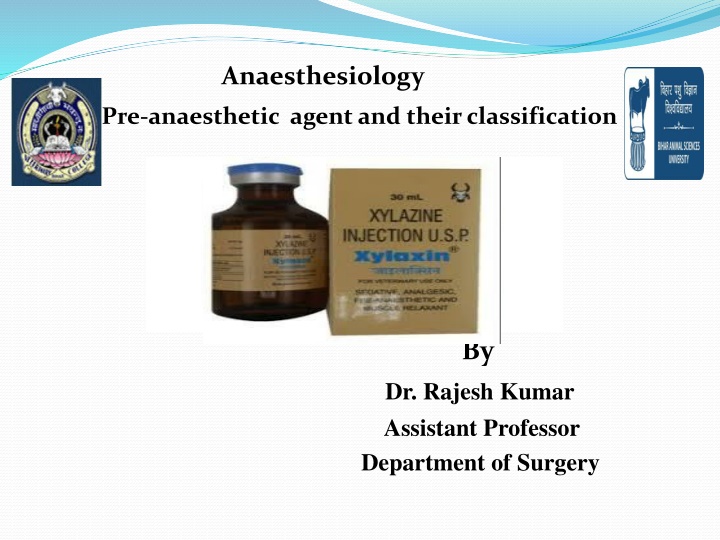
Pre-Anaesthetic Agents and Their Classification in Anaesthesiology
"Explore the role of pre-anaesthetic agents in preparing patients for anesthesia, including the classification of agents such as anticholinergics, tranquilizers, sedatives, and opioid analgesics. Learn about the importance of pre-surgical laboratory tests and selecting anesthetic agents based on the patient's risk potentiality. Discover how anticholinergic agents like Atropine Sulphate work in inhibiting parasympathetic nerve impulses. Ensure proper patient evaluation and preparation for smooth anesthesia administration and surgery."
Download Presentation

Please find below an Image/Link to download the presentation.
The content on the website is provided AS IS for your information and personal use only. It may not be sold, licensed, or shared on other websites without obtaining consent from the author. If you encounter any issues during the download, it is possible that the publisher has removed the file from their server.
You are allowed to download the files provided on this website for personal or commercial use, subject to the condition that they are used lawfully. All files are the property of their respective owners.
The content on the website is provided AS IS for your information and personal use only. It may not be sold, licensed, or shared on other websites without obtaining consent from the author.
E N D
Presentation Transcript
Anaesthesiology Pre-anaesthetic agent and their classification By Dr. Rajesh Kumar Assistant Professor Department of Surgery
Pre Surgical Laboratory Test At least Packed cell volume (PCV) and plasma protein (PP) concentrations should be evaluated
Hyper proteinemia can indicate haemo-concentration and dehydration Drug responses can be affected by hypoproteinemia It has been recommended that pre operative PCV be 27-30% intra operative and post operative PCV be kept above 20%.
Anaesthetic Risk Potentiality to surviving anaesthesia and surgery According to ASA physical status of animal classified into five classes (I to V) Patient is a completely healthy Patient has mild systemic disease Patient has severe systemic disease that is not incapacitating. Patient has incapacitating disease that is a constant threat to life. A moribund patient who is not expected to live 24 hour with or without surgery.
Pre-anaesthetic agent: Agent who are usually given to prepare the patient for administration of anesthetic agent. Uses To reduce the amount of general anaesthetic To calm the patient so that anesthesia can be administrated without bright and struggling. To reduce gastric and intestinal motility and prevent vomiting while the patient is under anesthesia.
Classification of pre anaesthetic agent : (a)Anticholinergic agent (b) Tranquilizers or neuroleptics. (c) Sedative (d) Opoid analgesic agent / Nacrotic.
Anticholinergic agent Anticholinergic inhibit parasympathetic nerve impulses by selectivity blocking the binding of the neurotransmitter acetylcholine to its receptor in nerve cells. Atropine Sulphate Inhibits the muscarinic action of acetylcholine on structure inervated by post galglionic cholinergic nerve and on smooth muscle which respond to endogens, but not inverted
Effect of atropine sulphate Cardiovascular system Respiratory system Other physiological function 1. 2. 3.
Metabolism : Dog excretes some part of atropine intact via kidney and remaining part undergoes hepatic metabolism. Cat metabolizes the majority of the atropine in the liver Doses: Cattle = .04 to .06 mg/kg b.w. S/C or I/M Dog /Cat Horse Sheep/Goat Contraindication Overdose = .04 mg I/M or S/C = .02 mg to .05 mg I/M or S/C = .7mg/kg B.W. I/M or S/C




